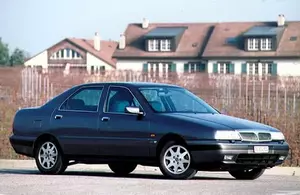
| Vehicle | Curb weight | Difference from world's smallest | Weight to power ratio | 0—60 mph acceleration ratio | Consumption ratio |
|---|---|---|---|---|---|
| 2.0 20V Turbo |
1455 kg / 3208 lbs |
1030 kg (2271 lbs) heavier | 7 kg to 1 hp | 217 kg/s (478 lbs/s) | - |
| 2.0 Turbo |
1455 kg / 3208 lbs |
1030 kg (2271 lbs) heavier | 7 kg to 1 hp | 211 kg/s (465 lbs/s) | - |
| 2.4 20V |
1425 kg / 3142 lbs |
1000 kg (2205 lbs) heavier | 8 kg to 1 hp | 172 kg/s (379 lbs/s) | - |
| 3.0 24V |
1515 kg / 3341 lbs |
1090 kg (2404 lbs) heavier | 7 kg to 1 hp | 176 kg/s (388 lbs/s) | - |
| Vehicle | 2.0 20V Turbo |
|---|---|
| Curb weight |
1455 kg / 3208 lbs |
| Difference from world's smallest | 1030 kg (1030 lbs) heavier |
| Weight to power ratio | 7 kg to 1 hp |
| 0—60 mph acceleration ratio | 217 kg/s (478 lbs/s) |
| Consumption ratio | - |
| Vehicle | 2.0 Turbo |
| Curb weight |
1455 kg / 3208 lbs |
| Difference from world's smallest | 1030 kg (1030 lbs) heavier |
| Weight to power ratio | 7 kg to 1 hp |
| 0—60 mph acceleration ratio | 211 kg/s (465 lbs/s) |
| Consumption ratio | - |
| Vehicle | 2.4 20V |
| Curb weight |
1425 kg / 3142 lbs |
| Difference from world's smallest | 1000 kg (1000 lbs) heavier |
| Weight to power ratio | 8 kg to 1 hp |
| 0—60 mph acceleration ratio | 172 kg/s (379 lbs/s) |
| Consumption ratio | - |
| Vehicle | 3.0 24V |
| Curb weight |
1515 kg / 3341 lbs |
| Difference from world's smallest | 1090 kg (1090 lbs) heavier |
| Weight to power ratio | 7 kg to 1 hp |
| 0—60 mph acceleration ratio | 176 kg/s (388 lbs/s) |
| Consumption ratio | - |

| Vehicle | Curb weight | Difference from world's smallest | Weight to power ratio | 0—60 mph acceleration ratio | Consumption ratio |
|---|---|---|---|---|---|
| 2.4 20V |
1520 kg / 3352 lbs |
1095 kg (2415 lbs) heavier | 9 kg to 1 hp | 179 kg/s (395 lbs/s) | - |
| 2.0 20V Turbo |
1550 kg / 3418 lbs |
1125 kg (2481 lbs) heavier | 7 kg to 1 hp | 212 kg/s (467 lbs/s) | - |
| 2.0 20V |
1510 kg / 3330 lbs |
1085 kg (2393 lbs) heavier | 10 kg to 1 hp | 159 kg/s (351 lbs/s) | - |
| 2.4 JTD |
1580 kg / 3484 lbs |
1155 kg (2547 lbs) heavier | 12 kg to 1 hp | 153 kg/s (337 lbs/s) | - |
| 2.4 TD |
1485 kg / 3274 lbs |
1060 kg (2337 lbs) heavier | 12 kg to 1 hp | 136 kg/s (300 lbs/s) |
195 kg/L (430 lbs/L) |
| 3.0 24V |
1610 kg / 3550 lbs |
1185 kg (2613 lbs) heavier | 8 kg to 1 hp | 171 kg/s (377 lbs/s) |
148 kg/L (326 lbs/L) |
| Vehicle | 2.4 20V |
|---|---|
| Curb weight |
1520 kg / 3352 lbs |
| Difference from world's smallest | 1095 kg (1095 lbs) heavier |
| Weight to power ratio | 9 kg to 1 hp |
| 0—60 mph acceleration ratio | 179 kg/s (395 lbs/s) |
| Consumption ratio | - |
| Vehicle | 2.0 20V Turbo |
| Curb weight |
1550 kg / 3418 lbs |
| Difference from world's smallest | 1125 kg (1125 lbs) heavier |
| Weight to power ratio | 7 kg to 1 hp |
| 0—60 mph acceleration ratio | 212 kg/s (467 lbs/s) |
| Consumption ratio | - |
| Vehicle | 2.0 20V |
| Curb weight |
1510 kg / 3330 lbs |
| Difference from world's smallest | 1085 kg (1085 lbs) heavier |
| Weight to power ratio | 10 kg to 1 hp |
| 0—60 mph acceleration ratio | 159 kg/s (351 lbs/s) |
| Consumption ratio | - |
| Vehicle | 2.4 JTD |
| Curb weight |
1580 kg / 3484 lbs |
| Difference from world's smallest | 1155 kg (1155 lbs) heavier |
| Weight to power ratio | 12 kg to 1 hp |
| 0—60 mph acceleration ratio | 153 kg/s (337 lbs/s) |
| Consumption ratio | - |
| Vehicle | 2.4 TD |
| Curb weight |
1485 kg / 3274 lbs |
| Difference from world's smallest | 1060 kg (1060 lbs) heavier |
| Weight to power ratio | 12 kg to 1 hp |
| 0—60 mph acceleration ratio | 136 kg/s (300 lbs/s) |
| Consumption ratio |
195 kg/L (430 lbs/L) |
| Vehicle | 3.0 24V |
| Curb weight |
1610 kg / 3550 lbs |
| Difference from world's smallest | 1185 kg (1185 lbs) heavier |
| Weight to power ratio | 8 kg to 1 hp |
| 0—60 mph acceleration ratio | 171 kg/s (377 lbs/s) |
| Consumption ratio |
148 kg/L (326 lbs/L) |

| Vehicle | Curb weight | Difference from world's smallest | Weight to power ratio | 0—60 mph acceleration ratio | Consumption ratio |
|---|---|---|---|---|---|
| 2.4 20V |
1450 kg / 3197 lbs |
1025 kg (2260 lbs) heavier | 8 kg to 1 hp | 175 kg/s (386 lbs/s) | - |
| 2.0 LE |
1450 kg / 3197 lbs |
1025 kg (2260 lbs) heavier | 10 kg to 1 hp | 156 kg/s (344 lbs/s) |
151 kg/L (333 lbs/L) |
| 2.0 20V |
1440 kg / 3175 lbs |
1015 kg (2238 lbs) heavier | 9 kg to 1 hp | 166 kg/s (366 lbs/s) | - |
| 2.0 20V Turbo |
1480 kg / 3263 lbs |
1055 kg (2326 lbs) heavier | 7 kg to 1 hp | 214 kg/s (472 lbs/s) | - |
| 2.4 JTD |
1510 kg / 3330 lbs |
1085 kg (2393 lbs) heavier | 11 kg to 1 hp | 159 kg/s (351 lbs/s) | - |
| 2.4 TD |
1450 kg / 3197 lbs |
1025 kg (2260 lbs) heavier | 12 kg to 1 hp | 121 kg/s (267 lbs/s) |
173 kg/L (381 lbs/L) |
| 3.0 24V |
1520 kg / 3352 lbs |
1095 kg (2415 lbs) heavier | 7 kg to 1 hp | 200 kg/s (441 lbs/s) | - |
| Vehicle | 2.4 20V |
|---|---|
| Curb weight |
1450 kg / 3197 lbs |
| Difference from world's smallest | 1025 kg (1025 lbs) heavier |
| Weight to power ratio | 8 kg to 1 hp |
| 0—60 mph acceleration ratio | 175 kg/s (386 lbs/s) |
| Consumption ratio | - |
| Vehicle | 2.0 LE |
| Curb weight |
1450 kg / 3197 lbs |
| Difference from world's smallest | 1025 kg (1025 lbs) heavier |
| Weight to power ratio | 10 kg to 1 hp |
| 0—60 mph acceleration ratio | 156 kg/s (344 lbs/s) |
| Consumption ratio |
151 kg/L (333 lbs/L) |
| Vehicle | 2.0 20V |
| Curb weight |
1440 kg / 3175 lbs |
| Difference from world's smallest | 1015 kg (1015 lbs) heavier |
| Weight to power ratio | 9 kg to 1 hp |
| 0—60 mph acceleration ratio | 166 kg/s (366 lbs/s) |
| Consumption ratio | - |
| Vehicle | 2.0 20V Turbo |
| Curb weight |
1480 kg / 3263 lbs |
| Difference from world's smallest | 1055 kg (1055 lbs) heavier |
| Weight to power ratio | 7 kg to 1 hp |
| 0—60 mph acceleration ratio | 214 kg/s (472 lbs/s) |
| Consumption ratio | - |
| Vehicle | 2.4 JTD |
| Curb weight |
1510 kg / 3330 lbs |
| Difference from world's smallest | 1085 kg (1085 lbs) heavier |
| Weight to power ratio | 11 kg to 1 hp |
| 0—60 mph acceleration ratio | 159 kg/s (351 lbs/s) |
| Consumption ratio | - |
| Vehicle | 2.4 TD |
| Curb weight |
1450 kg / 3197 lbs |
| Difference from world's smallest | 1025 kg (1025 lbs) heavier |
| Weight to power ratio | 12 kg to 1 hp |
| 0—60 mph acceleration ratio | 121 kg/s (267 lbs/s) |
| Consumption ratio |
173 kg/L (381 lbs/L) |
| Vehicle | 3.0 24V |
| Curb weight |
1520 kg / 3352 lbs |
| Difference from world's smallest | 1095 kg (1095 lbs) heavier |
| Weight to power ratio | 7 kg to 1 hp |
| 0—60 mph acceleration ratio | 200 kg/s (441 lbs/s) |
| Consumption ratio | - |